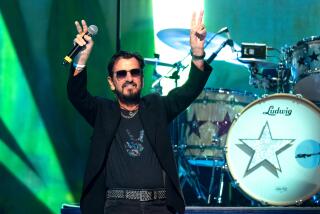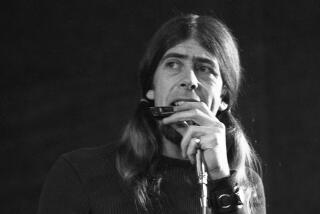MUSIC JIM HALL : A World Shaker : The jazz guitarist brings his sophisticated and subtle style to Santa Barbara in a rare West Coast trip.
- Share via
The editors of Guitar Player magazine this month announced their selection of 25 guitarists “who shook the world”--a largely loud, fast and brash group including Jeff Beck, Jimi Hendrix, Eddie Van Halen and John McLaughlin. But among them is Jim Hall, the lone died-in-the-wool jazz player in the group.
Hall, who comes to the Savoy Theater in Santa Barbara on Sunday, is a master of understatement.
At 61, he has shaken the jazz world with three decades of music-making, but it’s been a long, gentle temblor rather than a seismic ripsnorter. Since his emergence in the early ‘50s, Hall has been honing a sophisticated and subtle style, in contrast to more extroverted exponents of the electric guitar.
“Sometimes I wish I had the facility to play too fast,” Hall said, laughing, in a recent phone interview from his home in Greenwich Village. “I’ve tried to go the other direction--to rely on minimalist techniques. There are different ways of drawing attention.
“The first guy I heard who really imprinted himself on me was (swing era jazz guitarist) Charlie Christian, who--unbelievable a player as he was--you never felt played one note extra. That was my guide.”
Hall makes a rare trip West with his quartet this week, playing “The Tonight Show,” club dates in Los Angeles and San Francisco, and the Savoy show, which is his first appearance in Santa Barbara.
Hall isn’t a complete stranger to this coast. After graduating from Cleveland Institute of Music in 1955, Hall moved to Los Angeles, staying three years before migrating east. He went on to play with Lee Konitz, Sonny Rollins and Art Farmer, among others, and had the guitar chair on “The Merv Griffin Show” while it was in New York.
“By 1958, I was a permanent New Yorker, I still haven’t really gotten used to it, frankly, nor did I get used to Los Angeles. I grew up in the Midwest, in Ohio, so both places are a little extreme for me.”
On stage, his present working group includes drummer Terry Clarke, bassist Steve LaSpina and pianist Larry Goldings, whom Hall met while teaching at New York’s New School.
“He’s 23 and is really remarkable,” Hall said. “Like the Marsalises, Larry is really interested in the past. His rhythm feeling is like Oscar Peterson and Wynton Kelly. I don’t know where he got it. It’s hard to figure out talent.”
The quartet recently recorded an album for MusicMasters, with a guest appearance by harmonica legend Toots Thielemans.
“My philosophy--even though I don’t think about it consciously--is to include and be welcoming to the audience and then take them someplace they might not have expected to go, rather than to be off-putting from the first downbeat,” Hall said. “But in the course of an evening, we’re liable to go in any direction.”
Hall contends that he has an abiding respect for jazz standards but likes to keep his options open. In his hands, a Duke Ellington standard “might include parts of other Ellington tunes--not really a medley, but sort of a dream fantasy on a Duke tune. It’s a bit like theme and variation.”
Beginning with the drummerless Jimmy Giuffre trio, Hall has been involved in duets and trios. His 1972 “Alone Together” album with Ron Carter is something of a classic, as is “Power of Three,” a 1986 collaboration with pianist Michel Petrucciani and saxophonist Wayne Shorter.
The lure of music made in small groups, Hall said, is “the clarity of it, where each part is really essential and clear. I like big bands too, but somehow I don’t function as well in them. I like to boil things down to three parts, actually. Maybe it’s from all those years of writing counterpoint in music school.”
Hall’s stint as an educator has left its mark on countless younger jazz guitarists, including John Abercrombie and John Scofield, two mainstays of the current jazz guitar scene. A more serious student of Hall’s is idiosyncratic guitarist Bill Frisell (also in the “Guitar Player 25”), who cited Hall and Hendrix as two major influences.
Hall’s role in the world of jazz guitar was acknowledged under a spotlight during the 1990 JVC Jazz Festival in New York City, when organizers staged a “Jim Hall Invitational” concert at New York’s Town Hall. The program featured Hall and a long list of notable guests and is recorded on “Jim Hall and Friends,” a two-volume release on the MusicMasters label.
“It was like a party for me,” Hall said, “because each person who came out was an old friend. Even the guy who put the string quartet together, Kermit Moore, went to music school with me 200 years ago. . . . It was going to be called a tribute, and I nixed that right away. It sounds like I’m getting a gold watch or else I’ve died.”
On the contrary, Hall will solo on the next Gary Burton album, plans to record a series of original compositions for guitar and string and brass ensembles, and recently published a guitar study book, “Jim Hall: Exploring Jazz Guitar.”
In the book, Hall mixes musical examples with writings on music, literature and other art forms to teach “improvising in a compositional way, which is what I’ve kind of brought myself up to do.”
* WHERE AND WHEN
Jim Hall and his quartet will play at the Savoy Theater, 409 State St., Santa Barbara, at 7:30 p.m. Sunday. Tickets: $12.50, $10 students and senior citizens. Information: 563-2063.
More to Read
The biggest entertainment stories
Get our big stories about Hollywood, film, television, music, arts, culture and more right in your inbox as soon as they publish.
You may occasionally receive promotional content from the Los Angeles Times.








